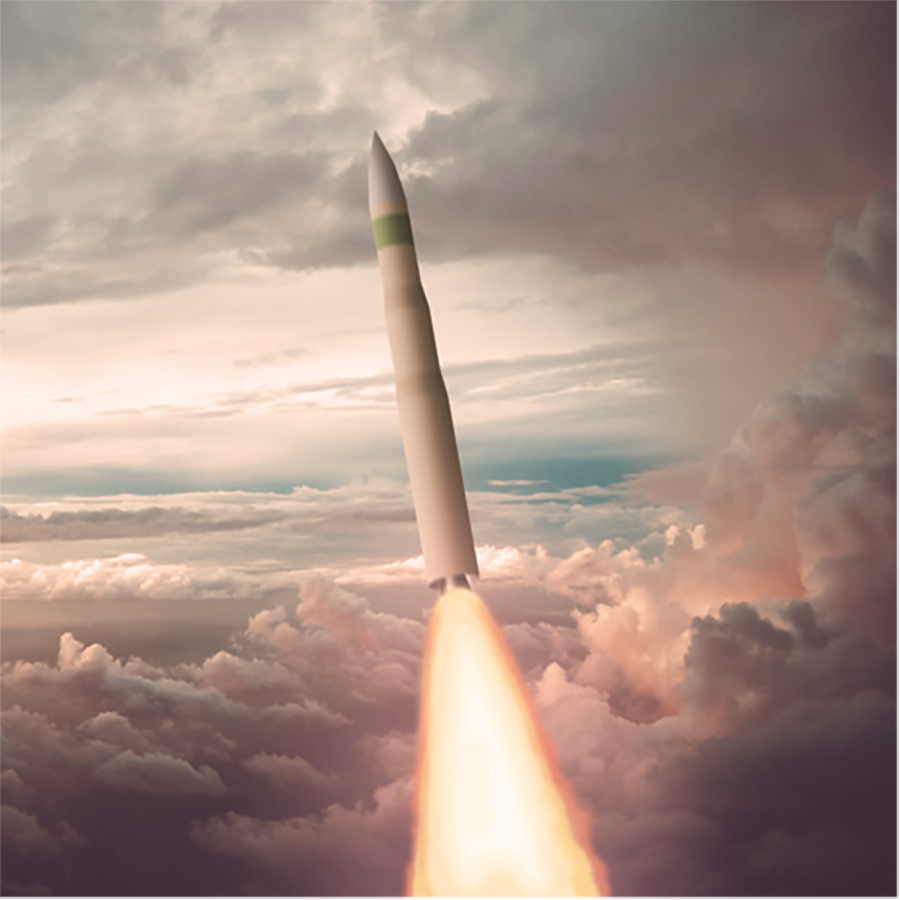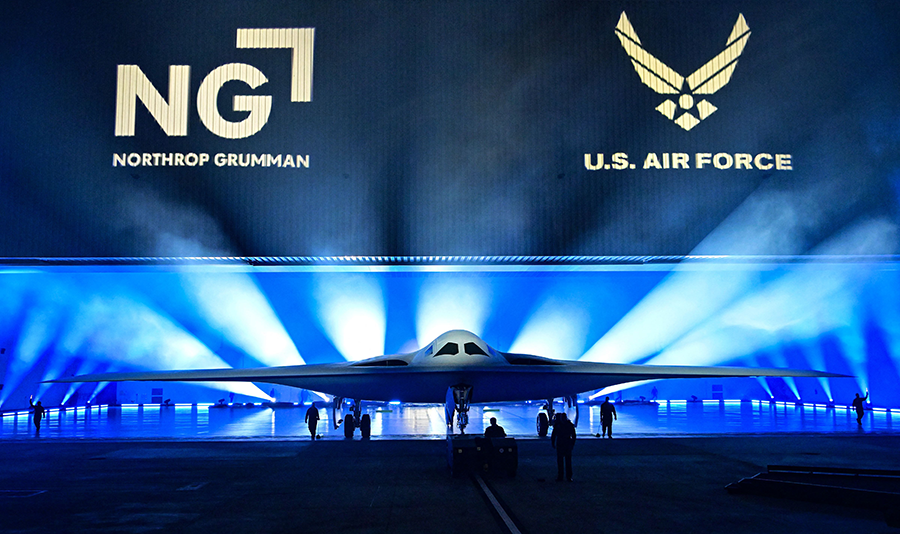"The Arms Control Association’s work is an important resource to legislators and policymakers when contemplating a new policy direction or decision."
New U.S. ICBMs May Be Delayed Two Years
May 2023
By Shannon Bugos and Gabriela Iveliz Rosa Hernández
The new U.S. Sentinel intercontinental ballistic missile (ICBM) program may face a delay of two years due to supply chain issues and an absence of skilled engineers, although the Pentagon aims to shorten the lag time by adjusting the program’s acquisition plan.
 The Sentinel program “may miss its goal of initial deployment in May 2029 by as much as two years, according to information presented at a high-level Pentagon review last month,” Bloomberg first reported on March 23.
The Sentinel program “may miss its goal of initial deployment in May 2029 by as much as two years, according to information presented at a high-level Pentagon review last month,” Bloomberg first reported on March 23.
The Air Force said in a statement to Bloomberg that it has “identified and is ready to execute acquisition strategy changes to reduce risk and optimize schedule, wherever possible.” Deborah Rosenblum, assistant secretary of defense for nuclear, chemical, and biological defense programs, told the House Armed Services Committee on March 28 that the $96 billion program remains a top priority for the Pentagon.
Air Force Secretary Frank Kendall sparked initial speculation in November about potential delays when he told a defense event in Washington, “I am concerned about the schedule, specifically for Sentinel.”
The Pentagon requested $3.7 billion for continued research and development and $539 million for initial procurement of the Sentinel system for fiscal year 2024. The Air Force aims to purchase a total of about 650 Sentinel ICBMs and deploy 400 of them to replace Minuteman III ICBMs. In April, the Defense Department began to solicit proposals for a new reentry vehicle to carry the nuclear warhead for the Sentinel missiles.
In its 2024 budget proposal, the Biden administration requested $56.5 billion for nuclear weapons-related activities at the Defense Department, which oversees nuclear weapons delivery vehicles, and the National Nuclear Security Administration (NNSA), which oversees nuclear warheads. Overall, the Pentagon is seeking a total budget of $842 billion, a 3 percent increase from the 2023 appropriation, and the NNSA is seeking $18.8 billion, a 10 percent increase from the 2023 appropriation. (See ACT, April 2022.)
The Pentagon’s request was informed by the fact that the United States is facing for the first time “two major nuclear powers, whose vital national security interests are in competition” with the United States, Gen. Mark Milley, chairman of the Joint Chiefs of Staff, told Congress on March 29. “Both China and Russia have the means to threaten U.S. national security…but war with either is neither inevitable nor imminent.”
Two nuclear weapons capabilities endorsed by the Trump administration but denounced by the Biden administration were cut in the new budget request. This reflects the 2022 Nuclear Posture Review, which stated that the Biden administration would not proceed with plans for the development of a nuclear-armed sea-launched cruise missile (SLCM) or the life extension program for the megaton class B83-1 gravity bomb. (See ACT, January/February 2023; December 2022.)
Funding for the SLCM and its associated nuclear warhead, the W80-4, was eliminated in the request, although Congress could reverse this later. For fiscal year 2023, Congress appropriated $25 million for the SLCM and $20 million for the warhead despite no such request from the administration.
In a marked change from his predecessor, Gen. Anthony Cotton, head of U.S. Strategic Command, did not explicitly express support for a nuclear-armed SLCM in a February letter to members of the Senate Armed Services Committee. The SLCM offers “additional options and supports an integrated deterrence approach,” he wrote, but “I support funding to assess the full range of possible options to address this challenge in a rapidly changing security environment with the backdrop of multiple nuclear adversaries.”
As for the B83-1 gravity bomb, the NNSA requested $31 million, but those funds would go to sustainment efforts to ensure the bomb’s safety and reliability rather than a life extension program.
 Meanwhile, the Defense Department’s other nuclear modernization programs continue apace. The Air Force requested $5.3 billion for R&D and construction of the B-21 Raider dual-capable strategic bomber, an increase from the fiscal year 2023 authorization of $4.9 billion. The Pentagon unveiled the bomber in December, and it will have its first flight test later this year. The Air Force plans to purchase at least 100 bombers.
Meanwhile, the Defense Department’s other nuclear modernization programs continue apace. The Air Force requested $5.3 billion for R&D and construction of the B-21 Raider dual-capable strategic bomber, an increase from the fiscal year 2023 authorization of $4.9 billion. The Pentagon unveiled the bomber in December, and it will have its first flight test later this year. The Air Force plans to purchase at least 100 bombers.
The Air Force also requested $978 million for the new nuclear-capable Long-Range Standoff (LRSO) weapons system, which includes $67 million for a second year of procurement. The service aims to buy about 1,000 LRSO missiles, with initial deployment in 2030.
The Navy asked for $6.1 billion for R&D and procurement of what ultimately will be a fleet of 12 Columbia-class ballistic missile submarines, a decrease of $1 billion from the 2023 appropriation.
The request would procure “the second Columbia-class submarine, our nation’s most survivable leg of the strategic triad, and [keep] us on track for the delivery of the first vessel in” 2028, Erik Raven, undersecretary of the Navy, said in a March 13 congressional briefing.
Although not a host for nuclear delivery systems, the Army has been developing a conventional, ground-launched midrange missile, a capability previously prohibited under the 1987 Intermediate-Range Nuclear Forces (INF) Treaty. This capability, known as the Typhon system, features modified Standard Missile-6 (SM-6) and Tomahawk cruise missiles. The Army received the first of four planned Typhon systems on Dec. 2.
For 2024, the Typhon program transitioned fully into the procurement phase, with the Army requesting $170 million for the procurement of 58 new Block V Tomahawk missiles.
Meanwhile, the NNSA budget seeks continued funding for the B61-12 gravity bomb, the W87-1 warhead, and the W-80 air-launched cruise missile programs at $450 million, $1.1 billion, and $1 billion, respectively.
The Federation of American Scientists reported on Jan. 9 that the deployment of B61-12 bombs to the six bases in Europe, which house an estimated 100 U.S. nuclear bombs under the NATO nuclear-sharing arrangement, appears imminent, if it has not begun already.
The NNSA also requested $390 million for an entirely new controversial warhead for submarine-launched ballistic missiles, the W93. The United Kingdom is pursuing a parallel nuclear warhead replacement program based on the W93 design. The Pentagon, meanwhile, requested $126 million for the warhead’s associated Mk7 aeroshell.
As for arms control and nonproliferation efforts, the NNSA requested $212 million, a 7.8 percent decrease from 2023 funding.
The NNSA is also in the midst of producing plutonium pits for nuclear weapons, an effort that has experienced significant delays in achieving the congressionally mandated goal of producing 80 pits per year by 2030. But Jill Hruby, NNSA administrator, reaffirmed to Congress on March 28 that the NNSA “remains firmly committed to achieving 80 [pits per year] as close to 2030 as possible.”
For 2024, the NNSA requested $921 million for pit production at Savannah River Site in South Carolina and $1.8 billion for the Los Alamos National Laboratory in New Mexico.
Meanwhile, the Missile Defense Agency set out its plan to continue efforts “to counter growing and more complex threats” and to improve the reliability and lethality of the Navy’s Aegis weapons system, including the SM variants.
On April 3, the agency announced the successful interception of a medium-range ballistic missile by two SM-6 interceptors fired simultaneously from an Aegis-equipped ship. The test marked the first interception of this class of missile in the terminal phase of flight by the SM-6 and the third successful test of an Aegis vessel using the SM-6.
For 2024 the agency requested a total of $1.8 billion for Aegis missile defense systems, including R&D on Aegis software and hardware, the development of land-based SM-3 missiles, and the procurement of 27 Aegis SM-3 Block IB missiles and 12 Aegis SM-3 Block IIA missiles for deployment at sea on Aegis ships and on land at the Aegis Ashore sites in Romania and Poland.
Vice Adm. Jon A. Hill, the agency director, said on March 14 that his organization is “very excited about where we are today” with the Poland site. “We completed construction, which was the major tip over into combat system installation and testing. That testing is going on now” and is scheduled to finish by this fall.
The agency also requested $2.1 billion for Next Generation Interceptor missiles, which are intended to replace the current Ground Based Interceptor missiles that are part of the Ground-Based Midcourse Defense system. The agency plans to begin supplementing the existing 44 ground-based missiles with 20 next-generation missiles no later than 2028, bringing the fleet total to 64.
The Biden administration’s request also includes continued funding of $351 million for the Cooperative Threat Reduction program, a slight decrease from the 2023 appropriation of $352 million. This program is aimed at reducing threats from weapons of mass destruction and related challenges, including the spread of dangerous pathogens such as the coronavirus.
